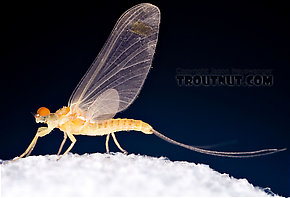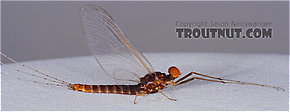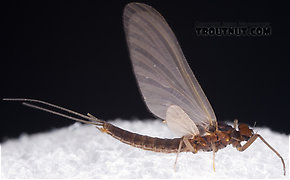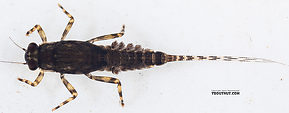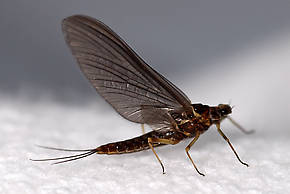Blog & Latest Updates
Fly Fishing Articles
Insects by Common Name


Red Quills
Scientific Names
Like most common names, "Red Quill" can refer to more than one taxon. They're previewed below, along with 12 specimens. For more detail click through to the scientific names.
Mayfly Species Ephemerella subvaria
These are often called Red Quills.
The Hendrickson hatch is almost synonymous with fly fishing in America. It has been romanticized by our finest writers, enshrined on an untouchable pedestal next to Theodore Gordon, bamboo, and the Beaverkill.
The fame is well-deserved. Ephemerella subvaria is a prolific species which drives trout to gorge themselves. Its subtleties demand the best of us as anglers, and meeting the challenge pays off handsomely in bent graphite and screaming reels.
The fame is well-deserved. Ephemerella subvaria is a prolific species which drives trout to gorge themselves. Its subtleties demand the best of us as anglers, and meeting the challenge pays off handsomely in bent graphite and screaming reels.
Ephemerella subvaria (Hendrickson) Mayfly Nymph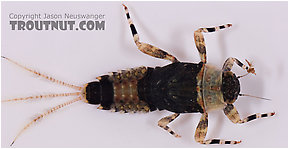 View 4 PicturesI've never seen this strange coloration on any Ephemerella subvaria nymph in a book before, but it's similar to several other specimens I collected on the same outing, including a smaller one that I photographed. They were outnumbered by the "normal" Ephemerella subvaria nymphs in the sample.
View 4 PicturesI've never seen this strange coloration on any Ephemerella subvaria nymph in a book before, but it's similar to several other specimens I collected on the same outing, including a smaller one that I photographed. They were outnumbered by the "normal" Ephemerella subvaria nymphs in the sample.
 View 4 PicturesI've never seen this strange coloration on any Ephemerella subvaria nymph in a book before, but it's similar to several other specimens I collected on the same outing, including a smaller one that I photographed. They were outnumbered by the "normal" Ephemerella subvaria nymphs in the sample.
View 4 PicturesI've never seen this strange coloration on any Ephemerella subvaria nymph in a book before, but it's similar to several other specimens I collected on the same outing, including a smaller one that I photographed. They were outnumbered by the "normal" Ephemerella subvaria nymphs in the sample.Male Ephemerella subvaria (Hendrickson) Mayfly Dun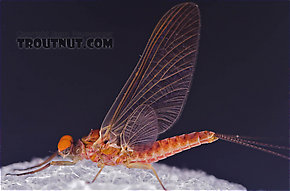 View 9 PicturesI collected this male Hendrickson dun and a female in the pool on the Beaverkill where the popular Hendrickson pattern was first created. He is descended from mayfly royalty.
View 9 PicturesI collected this male Hendrickson dun and a female in the pool on the Beaverkill where the popular Hendrickson pattern was first created. He is descended from mayfly royalty.
 View 9 PicturesI collected this male Hendrickson dun and a female in the pool on the Beaverkill where the popular Hendrickson pattern was first created. He is descended from mayfly royalty.
View 9 PicturesI collected this male Hendrickson dun and a female in the pool on the Beaverkill where the popular Hendrickson pattern was first created. He is descended from mayfly royalty.Male Ephemerella subvaria (Hendrickson) Mayfly Spinner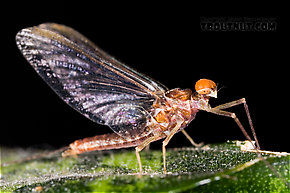 View 11 PicturesI collected this beautiful male Hendrickson specimen as a dun, along with a female Hendrickson from the same hatch. Both molted into spinners in my house within a couple of days.
View 11 PicturesI collected this beautiful male Hendrickson specimen as a dun, along with a female Hendrickson from the same hatch. Both molted into spinners in my house within a couple of days.
 View 11 PicturesI collected this beautiful male Hendrickson specimen as a dun, along with a female Hendrickson from the same hatch. Both molted into spinners in my house within a couple of days.
View 11 PicturesI collected this beautiful male Hendrickson specimen as a dun, along with a female Hendrickson from the same hatch. Both molted into spinners in my house within a couple of days.See 31 more specimens...
Mayfly Species Ephemerella invaria
These are sometimes called Red Quills.
This species, the primary "Sulphur" hatch, stirs many feelings in the angler. There is nostalgia for days when everything clicked and large, selective trout were brought to hand. There is the bewildering memory of towering clouds of spinners which promise great fishing and then vanish back into the aspens as night falls. There is frustration from the maddening selectivity with which trout approach the emerging duns--a vexing challenge that, for some of us, is the source of our excitement when Sulphur time rolls around.
Ephemerella invaria is one of the two species frequently known as Sulphurs (the other is Ephemerella dorothea). There used to be a third, Ephemerella rotunda, but entomologists recently discovered that invaria and rotunda are a single species with an incredible range of individual variation. This variation and the similarity to the also variable dorothea make telling them apart exceptionally tricky.
As the combination of two already prolific species, this has become the most abundant of all mayfly species in Eastern and Midwestern trout streams.
Ephemerella invaria is one of the two species frequently known as Sulphurs (the other is Ephemerella dorothea). There used to be a third, Ephemerella rotunda, but entomologists recently discovered that invaria and rotunda are a single species with an incredible range of individual variation. This variation and the similarity to the also variable dorothea make telling them apart exceptionally tricky.
As the combination of two already prolific species, this has become the most abundant of all mayfly species in Eastern and Midwestern trout streams.
Ephemerella invaria (Sulphur Dun) Mayfly Nymph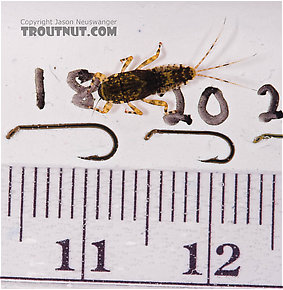 View 8 PicturesThis small Ephemerella invaria nymph was at least a month away from emergence.
View 8 PicturesThis small Ephemerella invaria nymph was at least a month away from emergence.
 View 8 PicturesThis small Ephemerella invaria nymph was at least a month away from emergence.
View 8 PicturesThis small Ephemerella invaria nymph was at least a month away from emergence.See 42 more specimens...
Mayfly Species Neoleptophlebia adoptiva
These are very rarely called Red Quills.
This is the best Spring hatch after the Quill Gordons (Epeorus pleuralis) but before the Hendricksons (Ephemerella subvaria) in most parts of the East, although it can overlap with both. The Blue Quills are small mayflies (hook size 16-20) but they can hatch in incredible numbers at a time when eager trout are just beginning to look to the surface after a hungry winter.
Male Neoleptophlebia adoptiva (Blue Quill) Mayfly Spinner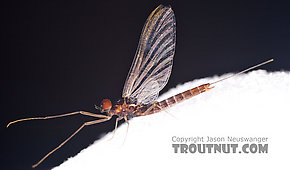 View 7 PicturesBased on the pale longitudinal forewing veins (excepting the costals), dark middle terga (Tergum: the dorsal part of an abdominal segment or segments (terga). Also used to describe the entire abdominal dorsum or the thoracic dorsal segments of Odonata.), and genitalia (Burks '53), this specimen is P. adoptiva.
View 7 PicturesBased on the pale longitudinal forewing veins (excepting the costals), dark middle terga (Tergum: the dorsal part of an abdominal segment or segments (terga). Also used to describe the entire abdominal dorsum or the thoracic dorsal segments of Odonata.), and genitalia (Burks '53), this specimen is P. adoptiva.
 View 7 PicturesBased on the pale longitudinal forewing veins (excepting the costals), dark middle terga (Tergum: the dorsal part of an abdominal segment or segments (terga). Also used to describe the entire abdominal dorsum or the thoracic dorsal segments of Odonata.), and genitalia (Burks '53), this specimen is P. adoptiva.
View 7 PicturesBased on the pale longitudinal forewing veins (excepting the costals), dark middle terga (Tergum: the dorsal part of an abdominal segment or segments (terga). Also used to describe the entire abdominal dorsum or the thoracic dorsal segments of Odonata.), and genitalia (Burks '53), this specimen is P. adoptiva.Mayfly Species Rhithrogena impersonata
These are very rarely called Red Quills.
This intriguing species has two distinct colors of nymphs, which were once considered to be different species. Most nymphs are a dark olive gray, but some are a surprisingly bright reddish brown. The red ones were once classified as Rhithrogena sanguinea. There is no apparent difference between the adults of the two varieties.
Rhithrogena impersonata (Dark Red Quill) Mayfly Nymph View 6 PicturesThis was the only Rhithrogena specimen in a large sample of nymphs from a small Catskill stream. It looks virtually identical to Rhithrogena impersonata specimens collected in the Midwest, but I didn't get to check the distinguishing features under a microscope.
View 6 PicturesThis was the only Rhithrogena specimen in a large sample of nymphs from a small Catskill stream. It looks virtually identical to Rhithrogena impersonata specimens collected in the Midwest, but I didn't get to check the distinguishing features under a microscope.
 View 6 PicturesThis was the only Rhithrogena specimen in a large sample of nymphs from a small Catskill stream. It looks virtually identical to Rhithrogena impersonata specimens collected in the Midwest, but I didn't get to check the distinguishing features under a microscope.
View 6 PicturesThis was the only Rhithrogena specimen in a large sample of nymphs from a small Catskill stream. It looks virtually identical to Rhithrogena impersonata specimens collected in the Midwest, but I didn't get to check the distinguishing features under a microscope.See 2 more specimens...
Mayfly Species Rhithrogena jejuna
These are very rarely called Red Quills.
Mayfly Species Ephemerella tibialis
These are very rarely called Red Quills.
Ehhemerella tibialis (Little Western Red Quill, Little Western Dark Hendrickson) is a common western species that can be very important at times. It is perhaps also one of the most confusing species. Unlike it's western generic counterparts the species is described as dark and their females produce dark eggs. Until recently, it was classified in the Serratella genus with species that share these traits. Regardless, it is the only small, dark ephemerellid the western angler is likely to find important. Favorite patterns used for size 18 Pale Morning Dun hatches tied in eastern Dark Hendrickson colors should be the ticket.
As with many of it's sister species it is widely adaptable and may be variable in its appearance. Scientific literature and many angling sources describe it as a small dark mayfly. Not everybody agrees. Ralph Cutter, West Coast author of several angler/entomology books and articles describes it in Sierra Trout Guide as a much larger pale mayfly and dubs it the Creamy Orange Dun. He also mentions the nymph as being easy to recognize by the faint dorsal (Dorsal: Top.) stripe running down its back and its often fiery brownish red color. These descriptions also match a variation of the ubiquitous and common Ephemerella excrucians.
As with many of it's sister species it is widely adaptable and may be variable in its appearance. Scientific literature and many angling sources describe it as a small dark mayfly. Not everybody agrees. Ralph Cutter, West Coast author of several angler/entomology books and articles describes it in Sierra Trout Guide as a much larger pale mayfly and dubs it the Creamy Orange Dun. He also mentions the nymph as being easy to recognize by the faint dorsal (Dorsal: Top.) stripe running down its back and its often fiery brownish red color. These descriptions also match a variation of the ubiquitous and common Ephemerella excrucians.
See 4 more specimens...
Mayfly Species Rhithrogena undulata
These are very rarely called Red Quills.
This is one of the two most common species of Rhithrogena.
Male Rhithrogena undulata (Small Western Red Quill) Mayfly Spinner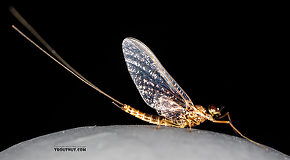 View 13 PicturesThis male was collected at the same time as this female and is likely the same species.
View 13 PicturesThis male was collected at the same time as this female and is likely the same species.
It keys pretty clearly to Rhithrogena undulata using the key in Traver 1935, although the size is larger than expected for that species in that source.
 View 13 PicturesThis male was collected at the same time as this female and is likely the same species.
View 13 PicturesThis male was collected at the same time as this female and is likely the same species.It keys pretty clearly to Rhithrogena undulata using the key in Traver 1935, although the size is larger than expected for that species in that source.
See 1 more specimens...
Top 10 Fly Hatches
Top Gift Shop Designs
Eat mayflies.
Top Insect Specimens
Miscellaneous Sites
Troutnut.com is copyright © 2004-2024 Jason
Neuswanger (email Jason). See my FAQ for information about use of my images.
 privacy policy
privacy policy

